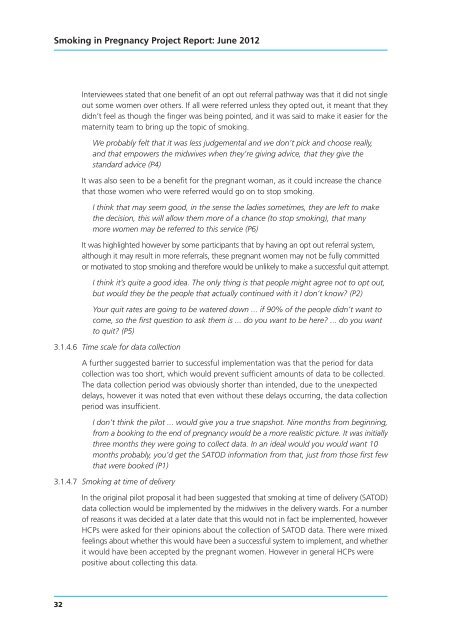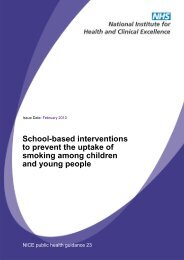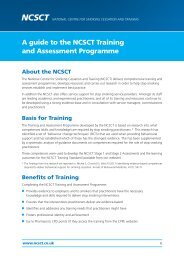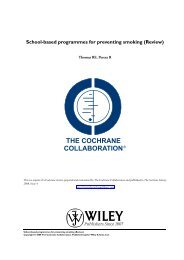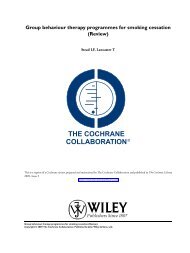published
published
published
Create successful ePaper yourself
Turn your PDF publications into a flip-book with our unique Google optimized e-Paper software.
Smoking in Pregnancy Project Report: June 2012<br />
Interviewees stated that one benefit of an opt out referral pathway was that it did not single<br />
out some women over others. If all were referred unless they opted out, it meant that they<br />
didn’t feel as though the finger was being pointed, and it was said to make it easier for the<br />
maternity team to bring up the topic of smoking.<br />
We probably felt that it was less judgemental and we don’t pick and choose really,<br />
and that empowers the midwives when they’re giving advice, that they give the<br />
standard advice (P4)<br />
It was also seen to be a benefit for the pregnant woman, as it could increase the chance<br />
that those women who were referred would go on to stop smoking.<br />
I think that may seem good, in the sense the ladies sometimes, they are left to make<br />
the decision, this will allow them more of a chance (to stop smoking), that many<br />
more women may be referred to this service (P6)<br />
It was highlighted however by some participants that by having an opt out referral system,<br />
although it may result in more referrals, these pregnant women may not be fully committed<br />
or motivated to stop smoking and therefore would be unlikely to make a successful quit attempt.<br />
I think it’s quite a good idea. The only thing is that people might agree not to opt out,<br />
but would they be the people that actually continued with it I don’t know? (P2)<br />
Your quit rates are going to be watered down ... if 90% of the people didn’t want to<br />
come, so the first question to ask them is ... do you want to be here? ... do you want<br />
to quit? (P5)<br />
3.1.4.6 Time scale for data collection<br />
A further suggested barrier to successful implementation was that the period for data<br />
collection was too short, which would prevent sufficient amounts of data to be collected.<br />
The data collection period was obviously shorter than intended, due to the unexpected<br />
delays, however it was noted that even without these delays occurring, the data collection<br />
period was insufficient.<br />
I don’t think the pilot ... would give you a true snapshot. Nine months from beginning,<br />
from a booking to the end of pregnancy would be a more realistic picture. It was initially<br />
three months they were going to collect data. In an ideal would you would want 10<br />
months probably, you’d get the SATOD information from that, just from those first few<br />
that were booked (P1)<br />
3.1.4.7 Smoking at time of delivery<br />
In the original pilot proposal it had been suggested that smoking at time of delivery (SATOD)<br />
data collection would be implemented by the midwives in the delivery wards. For a number<br />
of reasons it was decided at a later date that this would not in fact be implemented, however<br />
HCPs were asked for their opinions about the collection of SATOD data. There were mixed<br />
feelings about whether this would have been a successful system to implement, and whether<br />
it would have been accepted by the pregnant women. However in general HCPs were<br />
positive about collecting this data.<br />
32


